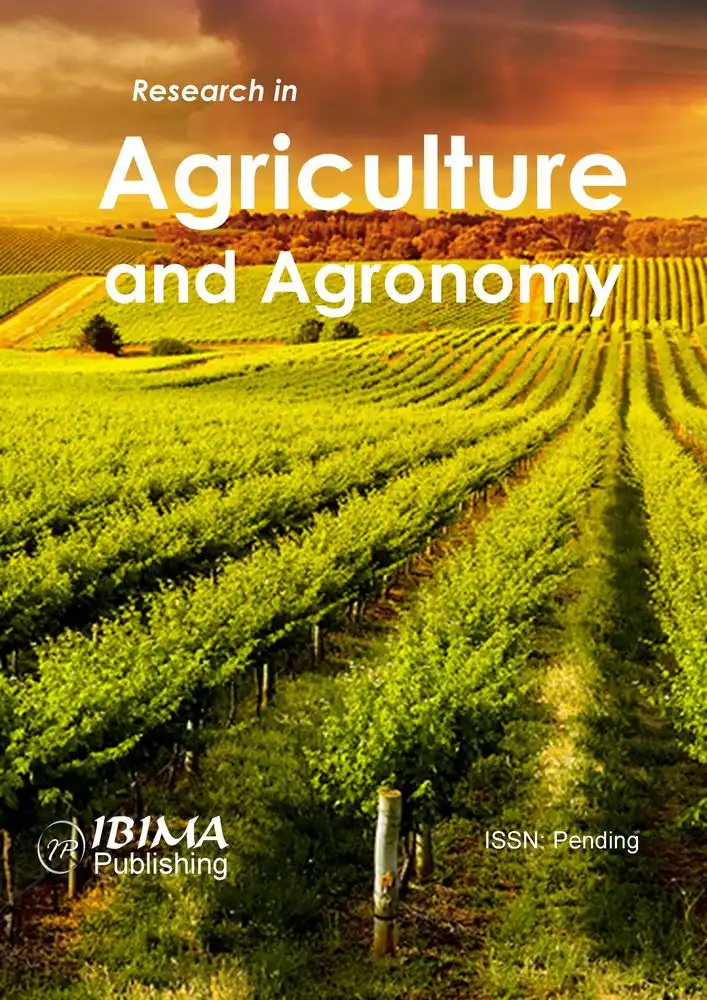Introduction
Gaining interest in the agronomical scientific community for the last 30 years [1], even though it is known to humankind from prehistorical times [2], Camelina sativa is an emerging crop worldwide. The rising interest in this plant amongst researchers is due to the multiple uses of its oil. Camelina oil has multiple uses, from cosmetics to biofuel for aviation industry [3]. Also due to its chemical composition especially fatty acid profile, it can be used in food and feed application [1,4,5]. This emphasises the high potential that this crop has for both industrial and nutritional applications [6] with a fatty acid profile constituted from more than 50% polyunsaturated fatty acids, especially linoleic and a-linolenic acid [7-9]. Also, recent discoveries are showing an antimicrobial effect of camelina oil due to its specific chemical composition [10]
As a crop, camelina isn’t a pretentious one. It can perform well on marginal lands where high valued crops may not be viable economically [11]. Camelina’s advantages over other oil crops are the low input agricultural requirements and a good tolerance to drought, cold, as well as to diseases or pests that commonly affect other Brassica crops, such as rape seed. [12-14].
Camelina is cultivated both in spring or autumn forms [15,16], and usually is reported with average yields varying from 1.3 t ha-1 to 1.9 t ha-1 [17], but newer varieties already perform better and can provide seed yield above 2 ha-1.
Although considered a low input crop by the vast majority of researchers, Jiang and Caldwell, found out that camelina reacted positively even to high doses of nitrogen up to 200 kg ha-1 [18]. This study is backed up by Mahli et al. [19], who also proved that camelina responds favourably to higher doses of nitrogen. The only question that remains is “how much is too much?” in order to avoid a negative impact on the environment. Therefore, an optimal dose of nitrogen should be found in order to obtain high yields with minimum impact on the environment. Such initiative was taken by Imbrea et.al [20] when they proposed municipal sludge as a novel fertilizer for camelina; Their results were promising, showing that the use of municipal sludge as a fertilizer reduces the effect of nitrogen on camelina oil’s fatty acid profile.
Another important aspect of the research, as pointed out by Kurasiak-Popowska et al. [21], is not just the quantity but also the quality of camelina yield.
Several studies pointed out that the main economically valuable characteristics of camelina are affected by the climatic conditions [7, 22-26].
Tests showed that the nutrient requirements for camelina vary from moderate to minimal, requiring the application of approximately 30 kg ha-1 phosphorus and 50 kg ha-1 of potassium before sowing. An important factor for camelina yield, both summer and winter form, is organic fertilizers. Organic fertilizers must be applied to the preceding crop, when it follows in crop rotation after spring crops [27]. It is recommended to apply 30-50 kg ha-1 N in vegetation [28].
Nitrogen is a very important element in the fertilization scheme of camelina. In the lack of this element, the plant has unpleasant aspect with small and yellow leaves, lesser pods and smaller seeds and the plant reaches maturity much faster [28].
Numerous studies have been done on camelina fertilization. Most studies report a favourable response to nitrogen and sulphur, but less to phosphorus. Increased productivity through nitrogen fertilization has been reported by several authors, but the amount of nitrogen required for maximum productivity varies [4] [29-35].
From an agronomic point of view, camelina is highly valuable due to the possibility of sowing both in spring and autumn, and although camelina falls into the category of plants with a low need for additional contribution, research shows that high yield increases have been obtained in optimal growing conditions even after fertilization with doses up to 200 kg / ha N [31] [35]. If fertilized with those high amounts, camelina ceases to be a low input plant.
This study was focused on the seed and oil yield variation of two camelina varieties when three different fertilization schemes were applied. The final aim of this research is to find a proper fertilization scheme for camelina crops in the western part of Romania.
Materials and Methods
Research Material and Field experiment
The research material consisted of two different camelina varieties of different origins: the first one was Mădălina, a Romanian camelina hybrid developed by Bucharest University of Agronomical Sciences and Veterinary Medicine, and the second one was Calena, an Austrian camelina variety, developed and commercialised by SAATBAU Linz eGen. This trial was conducted over the course of three agronomical years: 2018, 2019 and 2020.
The experimental field was set up at the Didactic Farm of Banat University of Agricultural Sciences and Veterinary Medicine “Regele Mihai I al României” from Timișoara (BUASVMT), situated on a plain landform, with the soil classified as a dark chernozem. (Figure 1).
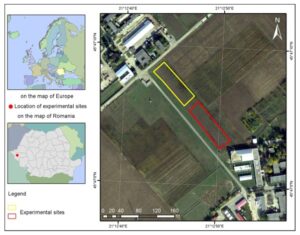
Figure 1: Experimental field location (Timișoara, Romania 45O47.079’N, 21O12.688’E)
This research area was chosen due to its proximity to the University and because the area is considered a landmark for agricultural research in the Western part of Romania.
Geographically speaking, Timis county is situated in the western part of Romania, neighboring Hungary and Serbia, being well known for the most fertile soil in the southeastern Europe.
The area where the experimental field was set up is framed in the zone of moderate continental climate. This area’s climatic conditions are specific for the south-eastern part of the Pannonian Plain with sub-Mediterranean influences [36]. The diversity and irregularity of the atmospheric processes are striking aspects of the general features of the Timisoara climate.
In spring, the dominant, temperate air masses with oceanic origin are carrying significant precipitation. Their influence is felt both in summer and in winter when frequently moist air masses of Atlantic origin arrive, causing significant snowfalls.
In autumn, starting with September, the masses of continental polar air make their presence felt frequently, coming from the east.
The sub-Mediterranean influences are due to the presence of the influence of cyclones and hot air masses with Mediterranean and Adriatic origins, which in winter are manifested by a complete thaw and in summer by hot periods.
The average annual temperature of the last ten years is 10.85, the maximum being recorded in July (21.6OC) and the minimum in January (-1.2OC).
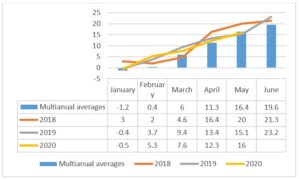
Figure 2. Temperature at Timisoara 2018-2020 compared to normal
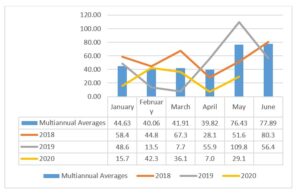
Figure 3. Rainfall at Timisoara 2018-2020 compared to normal
For the field experiment, a two-factorial split-plot in three replicates design with a total area of 1 ha (0.5 ha/variety) was set up and the pursued outcome was to observe the influence of different fertilization schemes on both seed and oil yield of the two camelina varieties taken into study. Being a 2 x 3 bifactorial experimental set up in subdivided plots, the two factors were as follows:
Factor A – Camelina variety (primary)
a1 – Mădălina
a2 – Calena
Factor B – Fertilization scheme (secondary)
b1 – N45P45K45
b2 – N66P57K45 + 24SO3 + 7CaO + 2Mg + 0.1 B +0.15 Zn
b3 – N101P78K45+ 48SO3 + 14CaO + 4Mg + 0.2 B +0.3 Zn
Sowing was done each year in the last decade of March (20.03-30.03), at a rate of 11 kgha-1, depending on meteorological conditions and the forerunner crop was wheat. Immediately after sowing, a rolling was done in order to even out the seedlings’ emergence. No herbicides or other crop protection substances were applied due to camelina’s resistance to pests and weeds.
Oil extraction (Laboratory analyses)
The seeds were harvested at full maturity and the oil was extracted in the Crop Science’s department laboratory within BUASVMT using a Gerhadt Soxhlet apparatus.
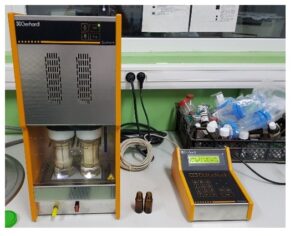
Figure 4. Oil extraction using Gerhardt Soxhlet apparatus
Results and Discussions
In order to determine the significance of the differences between the different graduations or combinations of the factors, the experimental data obtained were statistically interpreted by “analysis of variance” and the “t test”.
The meaning of differences was expressed both with symbols (*; 0) and letters (a,b; x,y,z). The differences between the variants marked with different letters were considered significant.
Seed yield of Camelina sativa
According to the variance analysis presented in table 1, it can be observed that the camelina variety, the fertilizing scheme and the interactions of these two factors had a considerable influence, statistically proven over camelina seed yield at Timisoara over the course of the studied period of time, 2018-2020. The climatic conditions had the highest contribution to the yield variability. (49.34%).
Different combinations of macro and micro elements had a significant contribution to the seed yield variability (29.59%), superior than the effect of the variety, which was only 11.54%. Also, the combined effect of the latter had a significant effect on camelina sativa seed yield. (1.02%). The results were influenced in a small measure by factors outside of the experimental field origin. (4.69%)
Table 1. Variance analysis for the effect of variety and fertilization on
camelina yield at Timisoara during 2018-2020
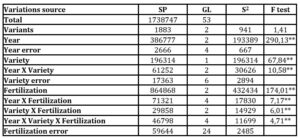
Looking at the unilateral effect of agronomical year (table 2) on the average yield of camelina, one can notice that the highest seed yield was recorded in the year 2019. Compared to the previous year, the yield difference of 89 kg/ha was statistically significant. In the year 2020, a yield decrease was recorded compared with 2018 and 2019.
Table 2. Yearly average yields for camelina recorded at Timisoara during 2018-2020

Over the studied period, at the level of the whole experience, Mădălina variety recorded a superior significant yield compared to the other variety taken into study, Calena. Madalina recorded a yield increase of 121 kg/ha, associated to a 6.08%.
Table 3. Average yields for camelina varieties recorded at Timisoara during 2018-2020

Average values of camelina seed yield under the effect of different combinations of macro and micro elements (table 4) have presented an amplitude of 116 kg/ha with the lower limit at 1889 in the case of N45P45K45 and the upper limit at 2198 kg/ha for N101P78K45 supplimented with microelements variant.
Taking into account the multiple comparisons between treatments in terms of seed production, it is found that the variant N101P78K45, supplemented with microelements, had a significantly higher efficiency than the other two combinations, materialized by increases between 6.39% compared to the variant N66P57K45 and 16.36 % compared to the N45P45K45 variant without microelements. Also, the application of the N66P57K45 variant with microelements allowed registering an increase of production by 9.37% compared to the simple variant N45P45K45.
Table 4. Average yields for fertilization treatments recorded at Timisoara during 2018-2020

B1 – N45P45K45;
B2 – N66P57K45+ 24SO3 + 7CaO + 2Mg + 0.1 B +0.15 Zn;
B3 – N101P78K45+ 48SO3 + 14CaO + 4Mg + 0.2 B +0.3 Zn
Considering the combined effect of the agricultural year and the variety on the production of camelina seeds in the period 2018 – 2020 in Timișoara (Table 5, figure 5), it is observed that in the case of 2020, the smallest difference between the 2 varieties was registered, an insignificant one, while in the rest of the years, the difference between the varieties is a higher one being also a significant one
Table 5. The effect of camelina variety on yield at Timisoara during 2018-2020
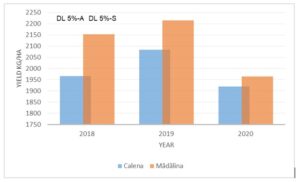
Figure 5. Yearly yield of camelina varieties recorded at Timisoara during 2018-2020
Considering the combined effect of the agricultural year and the fertilization level on the camelina production in Timișoara in the period 2018-2020 (table 6, fig 6), it is observed that the production differences between the agricultural year 2018 and 2020 related to the B1 fertilization level are not significant. A significantly different production increase was recorded in 2019. For higher levels of fertilization, supplemented with microelements, there are significant differences in production between years, the highest being in 2019 for both fertilization variants.
Table 6. The effect of fertilization on seed yield at Timisoara during 2018-2020


Figure 6. Yearly yield of camelina recorded at Timisoara during 2018-2020
Considering the combined effect of fertilization scheme and variety on camelina seed yield for the 2018 – 2020 (Table 7, figure 7), it is observed that the least difference between varieties was registered when N45P45K45 fertilizer was applied, while on the background of applying treatments supplemented with microelements, the differentiation between the production potential of the varieties was more obvious, being higher for the Madalina variety.
Table 7. The combined effect of variety and fertilization on seed yield at Timisoara during 2018-2020

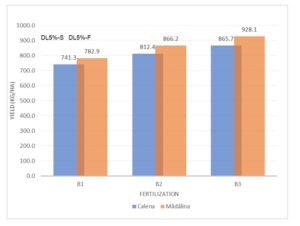
Figure 7. Yearly yield of camelina varieties under the effect of different fertilization schemes recorded at Timisoara during 2018-2020
The increased production in response to nitrogen fertilization was mainly due to a higher degree of branching and an increase in the number of silicules / sqm. Also, this affirmation is confirmed by other studies. [31] [35] [37].
Oil yield of Camelina sativa
As presented in Figure 8. Madalina variety recorded the highest oil content (40.90%), with the highest fertilization rate (N101P78K45 + 48SO3 + 14CaO + 4Mg + 0.2 B +0.3 Zn), and the lowest oil content (40.27%) for the Calena variety, when the lowest fertilization rate was applied (N45P45K45). Mineral fertilizers with NPK, combined with Cao, Mg, B and Zn, determined the increase of the oil content by 0.28% for the Calena variety on when the N66P57K45 + 24SO3 + 7CaO + 2Mg + 0.1 B +0.15 Zn fertilizer was applied, respectively 0.48% when fertilized with N101P78K45 + 48SO3 + 14CaO + 4Mg + 0.2 B +0.3 Zn.
In the case of the Madalina variety, the oil content increased by 0.26% with N66P57K45 + 24SO3 + 7CaO + 2Mg + 0.1 B +0.15 Zn fertilization, respectively 0.42% with the highest fertilization rate N101P78K45 + 48SO2 + 14 B +0.3 Zn, when compared to the control fertilization scheme (N45P45K45).
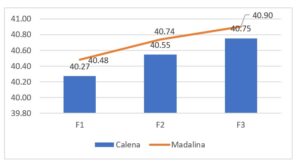
Figure 8. Evolution of oil content depending on variety and level of fertilization
According to the results of variance analysis presented in table 8, one can observe that both variety and fertilizing treatments, respectively the interaction of these two factors, had considerable influences, statistically approved, on the oil yield of camelina in this trial.
Different climatic conditions of the three different years over which this trial was overlayed had a significant contribution to the yield variability (29.07%).
The combination of different macro and microelements had the highest significant contribution to yield variability (38.59%), superior to the variety effect (15.35%). The combined effect of these two factors had a statistically significant influence on the oil yield of 2.34%.
Table 8. Variance analysis for the effect of variety and fertilization on camelina oil yield at Timisoara during 2018-2020
Considering the unilateral effect of the agricultural years on the oil yield, the highest value was recorded in 2019. In 2019, the oil yield was higher with 12.7 l/ha, the equivalent of 1.50%, compared to the value recorded in 2018. In 2020, the minimum value of oil yield was recorded.
Table 9. Yearly average yields for camelina oil yield recorded at Timisoara during 2018-2020

The highest oil yield, as a mean over the three years when this trial took place, was recorded by the Mădălina variety (859.1 l/ha). The difference of 52.6 l/ha is statistically significant. (Table 10)
Table 10. Average oil yield for camelina varieties recorded at Timisoara during 2018-2020

The average oil yield values, under the effect of different macro and micro elements, varied between 762.1 l/ha for the variant fertilized with N45P45K45 and 896.9 l/ha for the one fertilized with N101P78K45 supplemented with micro elements.
The most efficient fertilization variant was B3. The yield increase of this variant was 6.86% higher than B2 and 17.69% higher than B1. (Table 11)
Table 11. Average oil yields for fertilization treatments recorded at Timisoara during 2018-2020

B1 – N45P45K45;
B2 – N66P57K45+ 24SO3 + 7CaO + 2Mg + 0.1 B +0.15 Zn;
B3 – N101P78K45+ 48SO3 + 14CaO + 4Mg + 0.2 B +0.3 Zn
Table 12 and Figure 9 are presenting the combined effect of agricultural year and variety on the oil yield over the course of the 2018-2020 period. The least differences between the varieties were recorded in 2020, also being not statically significant. In 2018 and 2019, the differences were slightly higher and significant, statically speaking.
Table 12. The effect of camelina variety on oil yield at Timisoara during 2018-2020

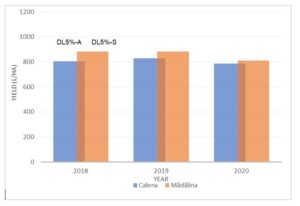
Figure 9. Yearly yield of camelina varieties recorded at Timisoara during 2018-2020
The combined effect of agricultural year and the fertilization level on the oil yield of camelina has no significant effect in 2018 and 2019 on neither fertilization level, but in the year 2020, between B2 and B3 fertilization levels can be noticed a significant difference, with a higher value in the latter. (Table 13, Fig. 10)
Table 13. The effect of fertilization on oil yield at Timisoara during 2018-2020

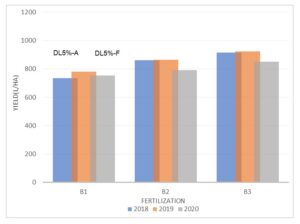
Figure 10. Yearly yield oil of camelina varieties on different fertilization schemes recorded at Timisoara during 2018-2020
Looking on the combined effect of fertilization scheme and camelina variety (Table 14, Fig.11), the least difference between varieties was recorded with the N45P45K45 fertilzation scheme. With a higher dose of fertilisants, Mădălina variety performed better and showing a higher increase of oil yield.
Table 14: The combined effect of variety and fertilization on oil yield at Timisoara during 2018-2020

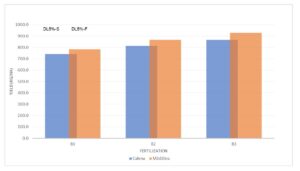
Figure 11: Yearly oil yield of camelina varieties under the effect of different fertilization schemes recorded at Timisoara during 2018-2020
Conclusions
The results from the experimental cycle 2018-2020 obtained in the experimental field from Timișoara show that both the variety and the fertilization treatments, respectively the interaction of these two factors, had considerable influences on camelina production, statistically ensured, but the climatic conditions had the highest contribution to the variability of production (49.34%).
The combinations of macro and microelements also had a significant contribution to the variability of production (29.59%), higher than the effect of variety of 11.54%. Also, the combined effect of the two factors showed a considerably lower influence than their separate effects on the level of camelina oil and seed yield.
Macro and microelements have a notable influence on camelina oil and seed yield. In the climatic conditions of Timișoara, the results presented an amplitude of 116 kg / ha, with the limits from 1889 in the case of the variant N45P45K45 to 2198 kg / ha for the variant N101P78K45 supplemented with microelements.
Looking on the seed yield of camelina and taking into account the multiple comparisons between treatments, it is found that the variant N101P78K45, supplemented with microelements, had a significantly higher efficiency than the other two combinations, materialized by a yield increase of 6.39% compared to the variant N66P57K45 and 16,36% compared to the N45P45K45 variant without microelements. Between N66P57K45 variant supplemented with microelements and N45P45K45, a seed yield difference of 9.37% was registered. All in all, Madalina is showing higher productivity results, both in seed and oil yield, and should be considered as a choice over other variety.
Author Contributions: All authors had a significant contribution to this paper. Conceptualization, S.B. and F.I.; methodology, F.C.; software, I.B.D., I.M.I.; validation, L.S., E.P..; formal analysis, F.I.; investigation, S.B.; resources, S.B.; data curation, S.B.; writing—original draft preparation, L.S.; writing—review and editing, E.P.; visualization, S.B., L.B.; supervision, I.F.; project administration, S.B and F.I.; All authors have read and agreed to the published version of the manuscript.
Funding: This research received no external funding
Acknowledgments
This paper is published from the funds of the Banat’s University of Agricultural Sciences and Veterinary Medicine from Timisoara.
Conflicts of Interest
The authors declare no conflict of interest
References
- Zanetti, F; Alberghini, B; Jeromela, A.M; Grahovac, Rajkovic, D; Kiprovski, B; Monti, A. Camelina, an ancient oilseed crop actively contributing tot the rural renaissance in Europe. A review. Agronomy for Sustainable Development, 41:2, https://doi.org/10.1007/s13593-020-00663-y
- Carciumaru, , 2007. Cultivarea plantelor in Dacia (Plants cultivation in Dacia) Thraco-dacica, VIII, 1-6.
- Laurențiu, B. Ș., Iuliana, P., Ilinca, I., Georgeta, P., & Florin, I. (2018). RAPE OIL VS CAMELINA OIL-A COMPARATIVE STUDY OF THEIR FATTY ACID PROFILE AND THEIR SUITABILITY FOR BIOFUEL PRODUCTION. International Multidisciplinary Scientific GeoConference: SGEM, 18(4.3), 519-525
- Zubr, J. (1997). Oil-seed crop: Camelina sativa. Industrial crops and products, 6(2), 113-119.
- Zubr J (2003) Dietary fatty acids and amino acids of Camelina sativa seed. J Food Qual 26(6):451–462. https://doi.org/10.1111/j.1745-4557.2003.tb00260.x
- Angelini, L.G.; Abou Chehade, L.; Foschi, L.; Tavarini, S. Performance and Potentiality of Camelina (Camelina sativa L. Crantz) Genotypes in Response to Sowing Date under Mediterranean Environment. Agronomy 2020, 10, 1929. https://doi.org/10.3390/agronomy10121929
- Meunier M., Guyard-Nicodeme M., Dory D., Chemaly M. 2016. Control strategies against Campylobacter at the poultry production level: Biosecurity measures, feed additives and vaccination. J. Appl. Microbiol. 120:1139–1173
- Imbrea, S. Jurcoane, H. V. Hălmăjan, M. Duda, L. Botoş. Camelina sativa: a new source of vegetal oils. Romanian Biotechnological Letters Vol. 16, No. 3, 2011
- Batrina, S Jurcoane, I Popescu, F Marin, IM Imbrea, F. Crista, F. Imbrea. Camelina sativa: a study on amino acid content. Romanian Biotechnological Letters Vol. 25, No. 1, 2020
- BĂTRÎNA Ș, CORCIONIVOSCHI N, JURCOANE S, LINTON M, KELLY C, PINKERTON L, IMBREA IM, SIMA F, IMBREA F. Camelina sativa oil can inhibit Campylobacter jejuni but stimulate lactic acid bacteria growth. Rom Biotechnol Lett. 2021; 26(2): 2423-2427. DOI: 10.25083/rbl/26.2/2423.2427
- Von Cossel, M.; Lewandowski, I.; Elbersen, B.; Staritsky, I.; Van Eupen, M.; Iqbal, Y.; Mantel, S.; Scordia, D.; Testa, G.; Cosentino, S.L.; Maliarenko, O.; Eleftheriadis, I.; Zanetti, F.; Monti, A.; Lazdina, D.; Neimane, S.; Lamy, I.; Ciadamidaro, L.; Sanz, M.; Esteban Carrasco, J.; Ciria, P.; McCallum, I.; Trindade, L.M.; Van Loo, E.N.; Elbersen, W.; Fernando, A.L.; Papazoglou, E.G.; Alexopoulou, E. Marginal Agricultural Land Low-Input Systems for Biomass Production. Energies 2019, 12, 3123. https://doi.org/10.3390/en12163123
- Gesch, R.W. and Cermak, S.C. (2011), Sowing Date and Tillage Effects on Fall‐Seeded Camelina in the Northern Corn Belt. Agronomy Journal, 103: 980-987. https://doi.org/10.2134/agronj2010.0485
- Wysocki, D.J.; Chastain, T.G.; Schillinger, W.F.; Guy, S.O.; Karow, R.S. Camelina: Seed yield response to applied nitrogen and sulfur. Field Crop Res. 2013, 145, 60–66.
- Séguin-Swartz, C. Eynck, R. K. Gugel, S. E. Strelkov, C. Y. Olivier, J. L. Li, H. Klein-Gebbinck, H. Borhan, C. D. Caldwell & K. C. Falk (2009) Diseases of Camelina sativa (false flax), Canadian Journal of Plant Pathology, 31:4, 375-386, DOI: 10.1080/07060660909507612
- Righini, D.; Zanetti, F.; Martínez-Force, E.; Mandrioli, M.; Toschi, T.G.; Monti, A. Shifting sowing of camelina from spring to autumn enhances the oil quality for bio-based applications in response to temperature and seed carbon stock. Ind. Crop. Prod.2019, 137, 66–73.
- Wittenberg, A.; Anderson, J.V.; Berti, M.T. Winter and summer annual biotypes of camelina have different morphology and seed characteristics. Ind. Crop. Prod. 2019, 135, 230–237.
- Jarecki, W. Reaction of Camelina (Camelina sativa (L.) Crantz) to Different Foliar Fertilization. Agronomy 2021, 11, 185. https://doi.org/10.3390/agronomy11010185
- Yunfei* Jiang and Claude D. Caldwell. Effect of nitrogen fertilization on camelina seed yield, yield components, and downy mildew infection. Canadian Journal of Plant Science. 96(1): 17-26. https://doi.org/10.1139/cjps-2014-0348
- S., JohnsonE. N., HallL. M., MayW. E., PhelpsS., and NyboB.. Effect of nitrogen fertilizer application on seed yield, N uptake, and seed quality of Camelina sativa. Canadian Journal of Soil Science. 94(1): 35-47. https://doi.org/10.4141/cjss2012-086
- Imbrea, F., Jurcoane, S., GEORGETA, P., ILINCA, M. I., Botos, L., Crista, F., & Smuleac, L. (2017). Valorising municipal sludge as fertiliser in Camelina sativa (L.) Crantz. Romanian Biotechnological Letters, 22(4), 12762.
- Kurasiak-Popowska D, Graczyk M, Stuper-Szablewska K. Winter camelina seeds as a raw material for the production of erucic acid-free oil. Food Chem. 2020; 330:127265. doi: 10.1016/j.foodchem.2020.127265
- Kon’kova, N.G.; Shelenga, T.V.; Gridnev, G.A.; Dubovskaya, A.G.; Malyshev, L.L. Stability and Variability of Camelina sativa (L.) Crantz Economically Valuable Traits in Various Eco-Geographical Conditions of the Russian Federation. Agronomy 2021, 11, 332. https://doi.org/10.3390/agronomy11020332
- Waraich, E.A.; Ahmed, Z.; Ahmad, R.; Ashraf, M.Y.; Naeem, M.S.; Rengel, Z. Camelina sativa, a climate proof crop, has high nutritive value and multiple-uses: A review. Aust. J. Crop Sci. 2013, 7, 1551–1559.
- Kon‘kova, N.G.; Malyshev, L.L.; Shelenga, T.V.; Ribakova, T.P.; Asfandiyarova, M.S. Source material for spring false flax (Camelina sativa (L.) Crantz) selection on the oil and protein content in different ecological-geographical conditions. J. Oil Crops 2012, 2, 44–50. (In Russian)
- Ghamkar, K.; Croser, J.; Aryamanesh, N.; Campbell, M.; Kon’kova, N.; Francis, C. Camelina (Camelina Sativa (L.) Crantz) As an Alternative Oilseed: Molecular and Ecogeographic Analyse. Genome 2010, 53, 558–567.
- Konkova, N.G.; Malyshev, L.L.; Asfandiyarova, M.S.H. Germplasm material for false flax (Camelina sativa (L.) Crantz.) breeding in the conditions of the Astrakhan region. Oil Crops 2020, 3, 75–83.
- Bugnăruc, C.I; Research regarding bio-ecology and productivity elements of Camelina Sativa L. Crantz. Doctoral Thesis, Banat University of Agricultural Sciences an Veterinary Medicine, 2001
- Donatas Koncius, The effect of nitrogen fertilisers, sowing time and seed rate on the productivity of Camelina sativa, Zemdirbyste 2010
- Urbaniak, S., Caldwell, C., Zheljazkov, V., Lada, R., Luan, L., 2008. The effect ofseeding rate: seeding date and seeder type on the performance of Camelinasativa L. in the Maritime Provinces of Canada. Can. J. Plant Sci. 88, 501–508.
- Gesch, R.W., Johnson, J.M.-F., 2015. Water use in camelina?soybean dual croppingsystems. Agron. J. 107, 1098–1104.
- Solis, A., Vidal, I., Paulino, L., Johnson, B.L., Berti, M.T., 2013. Camelina seed yieldresponse to nitrogen, sulfur, and phosphorus fertilizer in South Central Chile.Ind. Crops Prod. 44, 132–138
- Wysocki, D.J., Chastain, T.G., Schillinger, W.F., Guy, S.O., Karow, R.S., 2013.Camelina: seed yield response to applied nitrogen and sulfur. Field Crops Res.145, 60–66
- Mahli, S.S., Gan, Y., Raney, J.P., 2007. Yield, seed quality, and sulfur uptake ofbrassica oilseed crops in response to sulfur fertilization. Agron. J. 99, 570–577
- Sintim, H.Y., Zheljazkov, V.D., Obour, A.K., y Garcia, A.G., Foulke, T.K., 2015.Influence of nitrogen and sulfur application on camelina performance underdryland conditions. Ind. Crops Prod. 70, 253–259
- Jiang, Y., Caldwell, C.D., 2016. Effect of nitrogen fertilization on camelina seed yield,yield components, and downy mildew infection. Can. J. Plant Sci. 96, 17–26
- Şmuleac, L.; Rujescu, C.; Șmuleac, A.; Imbrea, F.; Radulov, I.; Manea, D.; Ienciu, A.; Adamov, T.; Pașcalău, R. Impact of Climate Change in the Banat Plain, Western Romania, on the Accessibility of Water for Crop Production in Agriculture. Agriculture 2020, 10, 437. https://doi.org/10.3390/agriculture10100437
- Jiang, Y., Caldwell, C.D., Falk, K.C., 2014. Camelina seed quality in response toapplied nitrogen, genotype and environment. Can. J. Plant Sci. 94, 971–980



